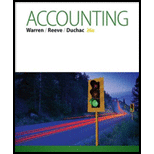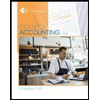
Concept explainers
(1) and (2)
General Journal
It is a chronological record of the transactions, showing an explanation of each transaction, the accounts affected, whether those accounts are increased or decreased, and by what amount. It has two columns i.e. Debit column and Credit column.
Special Journal
Special journal records a single kind of transactions that occurs frequently. For example: Revenue Journal is a special journal which records all revenue earned on account.
General ledger
It is the primary ledger, which contains all balance sheet and income statement accounts. For example: Cash Account, Equipment Accounts, and Rent Accounts etc.
Subsidiary ledger
A large number of individual accounts with a common characteristic can be grouped together in a separate ledger called subsidiary ledger. For example: Accounts Receivable subsidiary ledger or customer ledger.
Controlling Account
Each subsidiary ledger is represented in the general ledger by a summarizing account, called a controlling account. For example: Accounts Receivable Subsidiary ledger is represented in Accounts Receivable ledger.
To record: The transactions in General journal, Revenue journal, Accounts Receivable subsidiary ledger, and General ledger.
(3)a.
The sum of the balances of the customer accounts in the subsidiary ledger at 31st January 2016.
b.
The balance of the accounts receivable controlling account.
4.
To explain: The benefits of the computerized system over the manual system.
Trending nowThis is a popular solution!

Chapter 5 Solutions
Accounting (Text Only)
 Financial AccountingAccountingISBN:9781305088436Author:Carl Warren, Jim Reeve, Jonathan DuchacPublisher:Cengage Learning
Financial AccountingAccountingISBN:9781305088436Author:Carl Warren, Jim Reeve, Jonathan DuchacPublisher:Cengage Learning Financial AccountingAccountingISBN:9781337272124Author:Carl Warren, James M. Reeve, Jonathan DuchacPublisher:Cengage LearningCentury 21 Accounting Multicolumn JournalAccountingISBN:9781337679503Author:GilbertsonPublisher:Cengage
Financial AccountingAccountingISBN:9781337272124Author:Carl Warren, James M. Reeve, Jonathan DuchacPublisher:Cengage LearningCentury 21 Accounting Multicolumn JournalAccountingISBN:9781337679503Author:GilbertsonPublisher:Cengage- Principles of Accounting Volume 1AccountingISBN:9781947172685Author:OpenStaxPublisher:OpenStax College
 College Accounting, Chapters 1-27 (New in Account...AccountingISBN:9781305666160Author:James A. Heintz, Robert W. ParryPublisher:Cengage Learning
College Accounting, Chapters 1-27 (New in Account...AccountingISBN:9781305666160Author:James A. Heintz, Robert W. ParryPublisher:Cengage Learning





